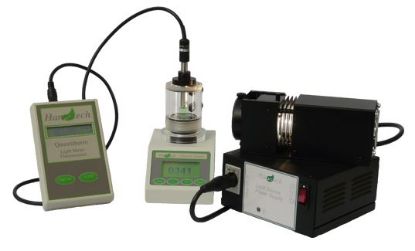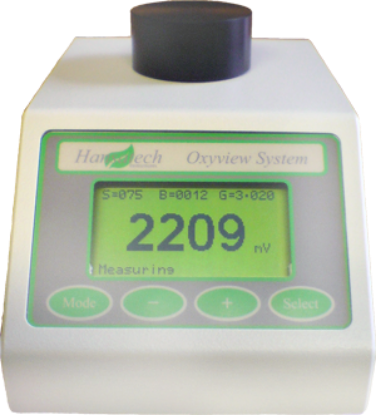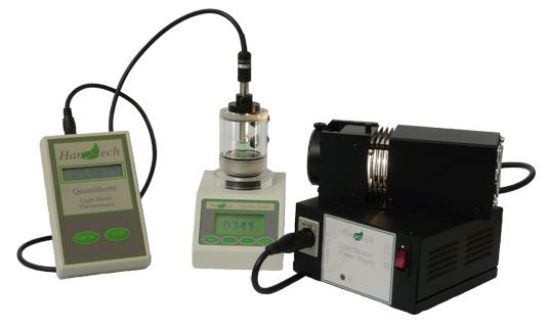Entry-level system for the study of photosynthesis & respiration
- Convenient, entry-level system for the study of photosynthesis & respiration measurements in liquid-phase samples under illumination
- Clear cast acrylic DW1 oxygen electrode unit with integral S1 electrode disc sensor
- Oxygen electrode control & signal acquisition via Oxyview control unit
- Oxygen signal output from Oxyview to recording device via 0 – 5V analogue output
- Illumination via LS2 high intensity tungsten halogen white light source
- LS2 intensity adjustable by insertion of neutral density filters
- Quantitherm light/temperature sensor for light source calibration
Overview
Chloroview 1 is an entry level system for studies of photosynthesis & respiration from liquid-phase suspension samples under actinic illumination. The system is ideally suited to teaching environments for under & post-grad plant biology studies of the photosynthetic processes but is equally at home in research facilities where demands on equipment performance are high.
Samples are typically between 0.2 – 2.5ml and consist of suspensions of extracted chloroplasts, micro-algae etc. Changes in oxygen concentration of the sample medium are determined by the integral oxygen electrode mounted in the base of the chamber.
The system comprises the Oxyview control unit, S1 Clark type electrode disc, DW1 liquid-phase electrode chamber, LS2 high intensity light source with neutral density filters to modify light intensities and QRT PAR/temperature sensor for light source calibration. All necessary accessories and spares are also included
(excluding circulating water bath and chart recorder).
Oxyview Control Unit

The OXYV1 Oxyview control unit has been designed as a convenient, low cost oxygen electrode control unit for teaching studies of photosynthesis and cellular respiration using the oxygen electrode measurement technique.
The Oxyview control unit is fully compatible with the range of oxygen electrode chambers produced by Hansatech Instruments thus allowing a wide range of different assays to be performed in both liquid and gas-phases.
The Oxyview is configured and controlled via a front mounted control panel featuring 4 touch-sensitive buttons. Configuration is achieved by navigating through a series of simple menu screens and following the displayed guidelines for each step of the setup process. These configuration steps include setting of the stirrer speed (for liquid-phase measurements) and back-off and gain settings. Once configured, the Oxyview control unit provides an accurate and stable reading of the oxygen content of the sample in question.
The Oxyview control unit has an integral magnetic stirrer for liquidphase applications allowing the overall footprint of the Oxyview 1 system to be minimal (90 x 135mm); convenient when multiple setups are required for teaching programmes in limited space.
The Oxyview control unit is powered by a 12V DC wall cube which connects directly to the rear of the unit. Also at the rear is a 0 – 5V analogue output. This allows the measured values from the control unit to be logged to an external recording device such as a chart recorder or similar datalogger accepting a 0 – 5V analogue input.
DW1

The DW1 oxygen electrode chamber provides a highly versatile solution to measurements of dissolved oxygen in liquid-phase samples. It can be used for a wide range of applications from basic teaching through to more advanced research assays.
The DW1 oxygen electrode chamber is constructed from clear cast acrylic providing good sample visibility & uniform illumination. Precise temperature control of the sample and electrode disc can be achieved by connecting the water jacket of the DW1 to a thermoregulated circulating water bath.
The sample is housed within a borosilicate glass reaction vessel which has a variable sample volume of between 0.2 and 2.5ml controlled by the adjustable plunger assembly.
This plunger has a stoppered central precision bore allowing additions/subtractions to be made to/from the reaction mixture using a standard Hamilton type syringe.
S1 Electrode Disk

The S1 electrode was designed in the early 1970’s during a collaborative project between Prof. David Walker, Prof. Tom Delieu and Hansatech Instruments. Since the first S1 oxygen electrode disc went on sale in 1974, the design and manufacturing process has remained largely unchanged in nearly 40 years – a true testament to the popularity, quality and reliability of the sensor.
A range of complementary instruments have been continuously developed over the years in order to meet the needs of emerging trends in the scientific world. Modern oxygen measurement systems incorporate the S1 electrode to provide sensitive and reliable tools for a vast range of applications from the demonstration of oxygen evolution from photosynthetic organisms to the analysis of mitochondrial respiration rates.
When prepared and fitted into an electrode chamber, the dome of the electrode disc forms the floor of the electrode chamber reaction vessel providing a sensitive and rapid response to small changes in oxygen tension within the sample.
The electrode disc comprises a central platinum cathode and a concentric silver anode. Preparation of the electrode includes the addition of electrolyte and the application of a thin oxygen permeable P.T.F.E. membrane to the electrode dome.
Once prepared and positioned in the electrode chamber, the disc is connected to an electrode control unit which applies a small polarising voltage between the platinum and silver electrodes. In the presence of oxygen, a small current is generated proportional to oxygen activity in the sample.
With modifications and in conjunction with accessory equipment, the S1 oxygen electrode disc may be used to measure other gasses such as hydrogen and nitric oxide.
LS2 High Intensity White Light Source

The LS2 light source is a high intensity (100W) tungsten halogen light source which is powered from a stabilised power supply.
The lamp housing contains a cooling fan, infrared reducing “Hot-Mirror” and optics to provide light with minimum variation of intensity across the beam and little divergence from parallel. 2 slots are provided to accept 50mm square optical filters or a manual shutter plate.
A range of light intensity steps may be achieved by adding permutations of the 4 A5 neutral density filters supplied (0.1,0.3,0.6 and 1.0 O.D.) to attenuate the light intensity. Maximum sample illumination intensities vary depending on the type of electrode chamber in use.
The table below shows the maximum achievable sample illumination intensities for each electrode chamber.
| Electrode Chamber | Maximum Intensity |
| DW1 | 1800 µmols m-2 s-1 with LS2 mounted horizontally to chamber. |
| DW1/AD | 1800 µmols m-2 s-1 with LS2 mounted horizontally to chamber. |
| DW2/2 | 8000 µmols m-2 s-1 with LS2/FO and A8 accessories to interface with DW2/2 optical port. |
| DW3 | 1800 µmols m-2 s-1 with LS2 mounted on to locating ring of larger optical window.8000 µmols m-2 s-1 with LS2/FO and A8 accessories and 16mm dia. reducing adapter (supplied with DW3) inserted into smaller optical port. |
| LD1/2 | 1800 µmols m-2 s-1 with LS2 mounted vertically on to optical window of the chamber. |
| LD2/3 | 1800 µmols m-2 s-1 with LS2 mounted vertically on to optical window of the chamber.8000 µmols m-2 s-1 with LS2/FO and A8 accessories inserted into 16mm dia. optical port. |
Quantitherm PAR/Temperature Sensor

The QRT1 Quantitherm light meter and thermometer is specifically designed for use with the DW1, DW2/2 and DW3 liquid-phase oxygen electrode chambers.
Quantitherm overcomes the potential difficulties associated with accurately measuring PAR light levels and temperature within the reaction vessel of liquid-phase oxygen electrode chambers during photosynthetic experiments.
The temperature sensor operates across the range of normal measuring temperatures used for both photosynthesis research and cellular respiration studies and offers maximum accuracy in the 10°C – 40°C region.
For photosynthesis research, the PAR quantum sensor provides a displayed resolution of 1µmol m-2 s-1 throughout the 0 to 5,000 µmol m-2 s-1 range and additionally will measure extreme saturating light intensities (such as those used in pulse saturation techniques for chlorophyll fluorescence analysis) up to a maximum of 50,000 µmol m-2s-1 with a displayed resolution of 10 µmol m-2 s-1.
QTP1 Probe

The QTP1 probe sensor connects to the QRT1 control unit via a MiniDIN connection at the top of the control unit. The probe is designed to be mounted directly into the DW series electrode chambers via the use of suitable mounting collars (mounting collar for DW1 and DW2/2 supplied, collar for DW3 supplied with DW3).
Despite being intended for light source calibration in liquid-phase oxygen electrode chambers, the PAR/temperature probe sensor must not be submerged in liquid. Although the probe is splash proof, prolonged contact with liquid will irreversibly damage the sensor. Calibration of light sources should be performed prior to the addition of samples. Damage caused by submersion will not be covered by warranty.
The probe provides both a PAR quantum sensor and a thermistor bead for temperature measurement and is constructed from stainless steel and acetal. Temperature is measured by an RT curve matched type glass bead thermistor mounted centrally in the probe tip. Photosynthetically Active Radiation (PAR) levels are determined by a quantum sensor located in the side wall of the probe.
The probe provides both a PAR quantum sensor and a thermistor bead for temperature measurement and is constructed from stainless steel and acetal. Temperature is measured by an RT curve matched type glass bead thermistor mounted centrally in the probe tip. Photosynthetically Active Radiation (PAR) levels are determined by a quantum sensor located in the side wall of the probe.
The QTP1 probe may also be connected directly to the rear of the Oxylab oxygen electrode control unit. O2view software plots the temperature signal from the QTP1 in real-time as a chart recorder emulation on the same screen as the signal from the S1 oxygen electrode disc. PAR values are also displayed in the O2view software light source calibration routine providing a convenient display of measured values during the 2-phase light source calibration process.
Accessories & Spares Supplied
- A2 Membrane applicator
- A3 Top plate key and alignment jig (for disassembly of DW1 electrode chamber)
- A5 Neutral density filter set
- S2/P Magnetic followers
- S3 Spare reaction vessels
- S4 30m roll of PTFE membrane
- S5 Spare O-rings for DW1 electrode chamber
- S16 Electrode cleaning kit



